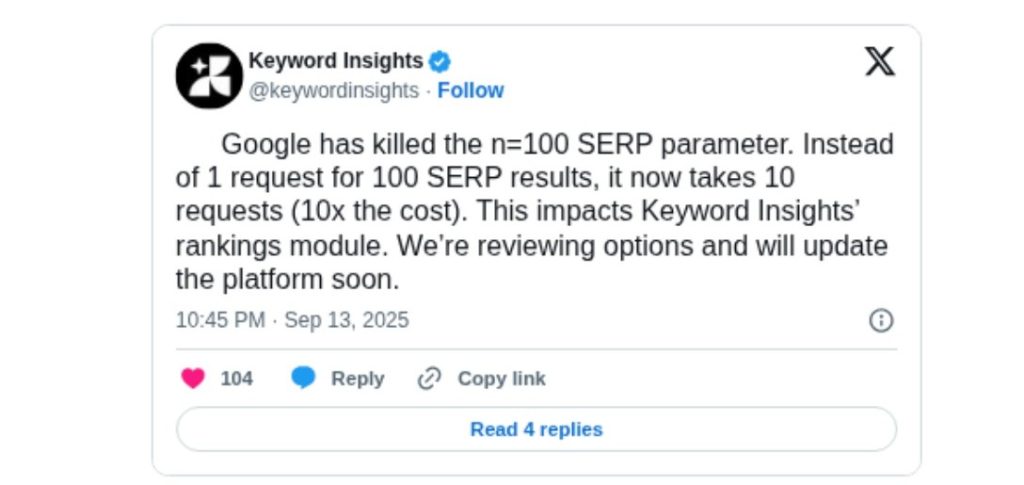Around September 10, 2025, SEO professionals noticed a significant shift in how Google handles a longstanding URL parameter: &num=100. This parameter allowed users (and tools) to show 100 results per page in Google search results. SEJ reports that this parameter may have been disabled or is under testing/removal.
This change has sparked ripples across SEO tool vendors, site owners, and data analysts — chiefly because it impacts how impressions, rankings, and SERP (Search Engine Results Page) scraping are conducted and interpreted. Let’s unpack what’s going on, why it matters, and what to do moving forward.
Table of Contents
ToggleWhat Exactly Changed
- The &num=100 search parameter is long-used to fetch 100 results in one page view.
- Since ~ Sept 10, 2025, forcing Google to show 100 results in one request often no longer works; in many cases, only 1 or 2 pages are accessible (i.e., fewer results), sometimes intermittently.
- Some rank‐tracking tools and platforms that relied on this for gathering data are showing gaps, errors, or missing rankings.
- Search Console data shows that desktop impressions dropped sharply around this time, and “average position” (how high your site appears) increased correspondingly.
Why SERP &num=100 Removal Matters (SEO Implications)
- Impression Inflation & Data Integrity
SEO/analytics tools that fetched 100 results per page were possibly counting a large number of impressions that normal users never see (because average users rarely scroll beyond the top few pages). Some of these impressions may have originated from bots or automated scripts. The change reduces or eliminates these inflated impressions.
- “Great Decoupling” Re-Examined
There has been discussion in the SEO world of rising impressions without matching clicks (“decoupling”). Some of that pattern may be attributable not to new search behaviors, but to how tools were gathering results (using &num=100). If many impressions were bot-generated or simply from deep SERP pages, they might never have been “real” potential for users.
- Tool & Reporting Disruption
Rank trackers, SEO dashboards, and keyword tools that assumed or depended on &num=100 are now facing failures, missing data, or need to increase the number of requests. More requests = more server load, potentially higher cost.
- Search Console Metrics May Shift
If a large chunk of previously reported impressions disappeared (because they were driven by bots / deep pages), you’ll see your metrics change — desktop impressions may drop, average positions may rise (i.e., your pages seem to rank “higher” on average). This doesn’t necessarily mean your site improved; it may just mean less noise.
Factual Statistics & Observations After Google Eliminates 100 Results Per Page

- Reports of the change began around September 10, 2025.
- Almost all tools that displayed 100 results per page saw disruptions: rank-tracker gaps, missing data.
- A large number of site owners noticed sharp declines in desktop impressions in Search Console right after the change.
- “Average position” metrics rose, meaning fewer results or impressions from periphery pages are being counted.
Keyword Insights Highlighted

For a complete overview of Google’s current ranking signals, read about the August 2025 SPAM update.
What Should SEO Professionals & Tool Vendors Do
- Audit your tools
Check which of your tools assume or require the &num=100 search parameter. Talk to vendors: are they adapting? Are they using alternative pagination or sampling methods?
- Rebaseline your metrics
Data post-Sept 10 is under a “new normal” for impressions/ranking metrics. Compare week-over-week carefully; treat the changes as qualitative resets, not necessarily declines in site performance.
- Filter out noise
If you’ve been seeing high naked impressions with low clicks, or impressions from pages beyond the first 10–20 results, see how much of it may have changed due to SERP &num=100 removal. Adjust expectations and projections accordingly.
- Monitor Google’s announcements
At the time of writing, Google has not confirmed via public statement whether the &num=100 search parameter removal is a test, a full rollout, or permanent. Keep an eye on the Webmaster Central blog and Search Console updates.
- Adapt scraping/gathering methods
If your workflow relies on scraping 100 results per page, consider changing to multiple smaller pages or using official APIs. Also, considering ethical and policy limits, Google may be intentionally limiting scraping.
Possible Long-Term Effects
- Reduced reliance on scraping deep SERP pages; better alignment between what users actually see and what tools report.
- Cost may increase for tool providers who must make 10x more requests to get the same amount of SERP data (if their workflows change). This could raise pricing or change how tools sample data.
- A more accurate picture of user behaviour, click-throughs, impressions — leading to possibly reinterpreting past data studies on SERP visibility, ranking vs visibility, etc.
- A push towards using Google’s official tools and APIs (where available) over scraping.
Conclusion
Google’s SERP &num=100 removal marks a meaningful change in how SERP data can be collected, interpreted, and trusted. For SEOs, this is more than a technical tweak; it potentially reshapes metrics around impressions, average position, and the perceived gap between visibility and traffic.
As with many Google changes, the best approach is to treat this as the new baseline: audit your tools, adjust your reporting, and focus on the metrics that most directly reflect user behavior (clicks, traffic, user engagement). Keep observing, and be ready to adapt.
FAQs
1. What is Google’s Removal of &num=100 Search Parameter?
Google’s removal of the &num=100 search parameter means that users can no longer force Google Search to show 100 results on a single search results page by appending &num=100 (or a similar value) to the search URL.
2. Why did Google remove or disable &num=100?
No official reason yet. Theories include: reducing load or abuse from scraping; limiting “bot inflation” of impressions; improving alignment between what regular users see vs. what tools show; or just experimenting to see effects. Until a Google statement, these remain hypotheses.
3. Will this change affect mobile search as well?
So far, most of the observed effects have been on desktop impressions and metrics. The article notes that desktop impressions are dropping. There’s less reporting about mobile, which typically has different behavior and display limitations. But tool workflows that aggregate across device types may see mixed effects.
4. Are my site’s rankings actually better now (because average position has improved)?
Not necessarily. The improvement in average position may simply reflect fewer low-visibility results being counted (e.g., from deep pages you are ranking low on). The change is likely reducing noise, not necessarily improving your site’s performance. To confirm, look at clicks, click-through rates, traffic, and user engagement, not just impressions or average position.
5. How can I adapt my SEO reporting strategy in light of this?
- Use week-over-week comparisons starting after Sept 10, 2025.
- Focus more on the top 10 / top 20 rankings rather than the deep rankings.
- Ensure your rank tracking tool uses reliable pagination or official APIs.
- Adjust forecasts or growth estimates that used inflated impressions.
6. Will past SEO research or analyses (which used data from tools relying on &num=100) be invalidated?
Not entirely invalidated, but some of the findings (especially those tied to visibility, impression growth, decoupling of clicks vs impressions) may need re-interpretation. Studies that didn’t control for parameter-based scraping inflation may have overstated visibility or impressions. Researchers should note this shift as a possible confounding variable when comparing pre- and post-September 2025 data.




